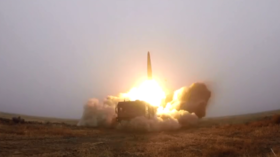Starliner blues: NASA blames ‘timing error’ for Boeing spaceship missing mark in orbit
The test flight of Boeing’s Starliner to the International Space Station was supposed to be a major step in the triumphant US return to crewed orbital spaceflight. Then something went wrong.
The CST-100 Starliner lifted off atop an updated Atlas V booster rocket on Friday morning, from Cape Canaveral in Florida. NASA Administrator Jim Bridenstine and executives from Boeing and the United Launch Alliance (ULA) were in attendance.
3… 2… 1… LIFTOFF! After a nominal launch from @NASAKennedy, we’re now looking forward to the arrival of @BoeingSpace’s #Starliner, part of our Commercial Crew Program, on its maiden voyage to the space station. pic.twitter.com/gTZOg6LocH
— Intl. Space Station (@Space_Station) December 20, 2019
No crew was on board; this was a fully automated test, with the mission of docking with the ISS in low Earth orbit and proving that the US can once again launch “launch American astronauts on American rockets from American soil,” as Bridenstine would later put it.
Our meteorologists watched the first #Starliner capsule headed up to space this morning. The Atlas V rocket carrying Starliner launched from Cape Canaveral at 6:36 a.m. Florida rocket launches just before sunrise or just after sunset are easily visible along the Carolina coast. pic.twitter.com/BmFAMuwwtl
— NWS Wilmington NC (@NWSWilmingtonNC) December 20, 2019
Everything went well, until it didn’t. Instead of executing a proper orbital burn after separation from the booster rocket, the Starliner engines misfired. The capsule found itself in a “stable” – but wrong – orbit, with Boeing and NASA scrambling to get it safely back to Earth.
“We had an off-nominal situation on orbit,” is how Kirk Shireman, NASA’s program manager for the ISS, phrased it.
“The anomaly appears to have been the result of a mission elapsed timer (MET) using an unexpected timeline, which delayed orbital insertion thruster firings, putting Starliner in an unplanned orbit,” Boeing said in a statement, about five hours after the launch.
I'm honestly very confused. Someone (@NASA or @BoeingSpace) needs to answer how in the heck Starliner is in a stable orbit if the Orbit Insertion Burn didn't take place and it was suborbital at Atlas V drop off. #Starliner#OFT
— Chris G - NSF (@ChrisG_NSF) December 20, 2019
Translated from government-speak, that means the on-board clock experienced a glitch and fired the engines at the wrong time. Nobody knows yet why or how this happened – or how such a thing could happen with a state-of-the-art spacecraft in 2019.
“We had, obviously, some challenges today,” Bridenstine said at a press conference addressing the mishap.
The NASA administrator tried to put a brave face the whole operation, telling reporters that “a lot of things went right” and that NASA was getting a lot more valuable information from the test this way. Aborting the attempt to reach the ISS and landing the Starliner at White Sands Missile Range in New Mexico was “absolutely the right decision.”
Also on rt.com Have spacesuit, will travel: NASA unveils new astronaut outfitMike Fincke and Nicole Mann, two astronauts involved with the Starliner program, insisted that they did not have any safety concerns with Boeing’s spaceship. Had either of them been on board, they could have used the Starliner’s “robust manual capability” to correct the course, they argued.
For all the pep talk coming from NASA, Boeing and ULA, the failed test is a major setback on their quest to restore crewed space capability that the US lost in 2011 with the end of the Space Shuttle program. Since then, the only way for NASA to send a crew to the ISS has been to buy seats on board the Soyuz spacecraft, operated by Russia’s space agency Roscosmos.
Boeing’s new Starliner space capsule goes off course on its first flight to the International Space Station. NASA has pumped over $4.2 billion into the project. It would have been a lot cheaper (and safer) to keep renting space on Russia’s Soyuz, which was first built in 1967. https://t.co/kbuAPtxjzf
— Bryan MacDonald (@27khv) December 20, 2019
While the modernized Soviet-era workhorse has been generally reliable and vastly less expensive compared to the cost of paying US companies to develop crewed spaceships, the issue is one of prestige and national pride. Earlier this year, as NASA celebrated the 50th anniversary of the Moon landing, it danced around the fact that it currently has no capability to send astronauts into orbit, much less repeat the feat of Apollo 11.
Boeing and SpaceX were supposed to have their spaceships ready by 2019, but both the Starliner and the Crew Dragon have run into testing mishaps, shifting the timeline and requiring NASA to keep booking seats aboard the Soyuz. With Friday’s failure of the Starliner, it seems that the earliest US crewed spaceflight won’t happen until 2021, a full decade after the last Shuttle flew.
Think your friends would be interested? Share this story!













